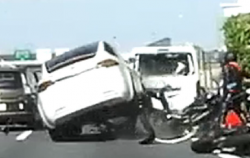
— A Tesla Autopilot lawsuit alleges a Model X with Autopilot engaged slammed into motorcycles, a van and pedestrians that were stopped on the side of a Japanese expressway, killing 44-year-old Mr. Yoshihiro Umeda.
According to the lawsuit, even though the driver was falling asleep at the wheel when the crash occurred, it was Tesla's Autopilot system which was responsible for the death of Mr. Umeda.
Based on court documents, motorcyclists were parked behind a small van on the far-right lane of the Tomei Expressway in Kanagawa, Japan on April 29, 2018. The group had stopped following a crash that involved someone who was riding with the group.
The lawsuit says Yoshihiro Umeda was part of this group and standing alongside several motorcycles which were parked in an effort to redirect traffic away from the scene of the crash.
According to the complaint, the driver of a 2016 Tesla Model X entered onto the Tomei Expressway and the driver turned on the Autopilot function, proceeding along the highway for about 30 minutes while tracking another vehicle in front of it.
The Model X event data recorder allegedly indicates at 2:22 p.m., Tesla’s Autopilot technology detected the driver’s hands on the steering wheel, and at 2:49 p.m., the vehicle that the Tesla had been tracking in front slowed down considerably.
The vehicle allegedly indicated by its blinkers it was preparing to switch to the immediate left-hand lane in order to avoid the group of parked motorcycles, pedestrians and the van that were ahead.
But according to the Autopilot lawsuit, at "some point before 2:49 p.m., the driver of the Tesla vehicle began to feel drowsy and had begun to doze off."
As the forward vehicle moved to the left, the Tesla allegedly began rapidly accelerating from about 9 mph to 24 mph, crashing into the motorcycles and running over the body of Mr. Umeda.
Even though the Tesla driver took no action to avoid the crash, the lawsuit alleges the fatality occurred because the Model X was defective.
"The driver of the Tesla Model X was found to have been dozing shortly before the crash, and Tesla will expectedly lay all of the blame for this tragic accident on this individual." - Autopilot lawsuit
The plaintiffs say the Tesla driver had his hands on the steering wheel as measured by Tesla’s Autosteer system, and none of the sensors and forward-facing cameras recognized the objects. In addition, the plaintiffs allege the automatic emergency braking function did nothing to automatically slow down the Model X.
The Model X owner's manual warns drivers of the limitations of the driver-assist features, but the lawsuit argues "Tesla failed to provide adequate warnings of such dangers."
According to the owner's manual, Tesla says its Autosteer technology is subject to circumstances that can interfere with system operations.
Tesla warns the systems can fail when unable to determine lane markings accurately or when bright light is interfering with the "camera’s view, visibility is poor, or the windshield area in the camera’s view is obstructed."
The Autopilot lawsuit references investigations performed by the National Transportation Safety Board (NTSB) related to automated systems and how automakers, including Tesla, should develop "applications to more effectively sense the driver’s level of engagement and alert the driver when engagement is lacking while automated vehicle control systems are in use."
Tesla uses driver-applied steering wheel torque to monitor driver engagement with Autopilot , but the lawsuit says the NTSB has concluded partial driving automation requires more than steering wheel input.
An NTSB investigation following a separate Tesla crash concluded one of the contributing factors of the crash was the “operational design of Tesla’s partial automation system, which permitted disengagement by the driver. The way the Tesla Autopilot system monitored and responded to the driver’s interaction with the steering wheel was not an effective method of ensuring driver engagement.”
According to the Autopilot lawsuit, four Tesla crashes investigated by the NTSB showed driver disengagements were factors in the incidents. Federal safety investigators also placed some of the blame on the drivers who weren't paying attention to objects in the road.
The NTSB can only make recommendations based on conclusions reached by investigators, but the agency cannot force automakers to make changes based on those recommendations.
Saying Tesla's suite of Autopilot features are defective, the plaintiffs claim their family member's death would have been avoided if Tesla's "willful disregard of recommendations by government safety regulators" wasn't a reality.
The Tesla Autopilot lawsuit was filed in the U.S. District Court For the Northern District of California, San Jose Division: Tomomi Umeda, et al., v. Tesla, Inc, et, al.
The plaintiffs are represented by the Law Offices of Edward C. Chen, and ZeLo Japan.




